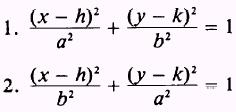2.
.

An ellipse usually looks like a squished circle. The equation for an ellipse is shown above. The ellipse consist of a center, major axis, minor axis, vertices, co-vertices,and foci. The center is a point inside the ellipse.
We can find the center by h,k. If we look at the equation we'll see that h will always go with x and y will always go with k. But we have to make sure we put it in h,k format. The major and minor axis intersect and go through the center. To find if the major axis is horizontal or vertical , we have to look at the standard form of the equation. It will be horizontal if the larger denominator is under the x^2 term and this means the ellipse will be fat. If the larger term is under the y^2 the major axis will vertical and skinny. The major axis can be demonstrated on the graph with a solid line and the minor with a dashed line. The vertex is two points at the end of the major axis. They can be found by it being "a" distance from a to the center. The two co-vertices are the end points of the minor axis. The co-vertices can be found by it being "b" distance from the ellipse. You count from the center. To plot the foci you must plot c units to the left/ right if x^2 has the larger value below it. Move and plot c units up/down if y^2 has the bigger number under it. To find any values for a, b, or c that aren't given use the formula a^2-b^2=c^2. Eccentricity must be between 0 and 1. This can be found by dividing c over a and rounding it three decimal places. For more information look at this website. (http://www.mathsisfun.com/geometry/ellipse.html)
3. Real World Application
Ellipses can be seen in our solar systems.. Although some objects follow circular orbits, most orbits are shaped more like "stretched out" circles or ovals.(http://www.windows2universe.org) Since the orbit of Earth around the Sun is very circular the eccentricity is very close to one. Like we can see in the video the foci of the solar system lies in the sun.
All planets have a different distance from the center because the planets are all spread around and not in a straight line. If we take a look the earth and the sun we can see that since the foci are together the and that is the reason why the Earth seems to revolve in a circle around the sun. The actual eccentricity is .0167. The major axis in the solar system would be the from the Earth to the sun and that same distance to the left/right.
4. References:

No comments:
Post a Comment